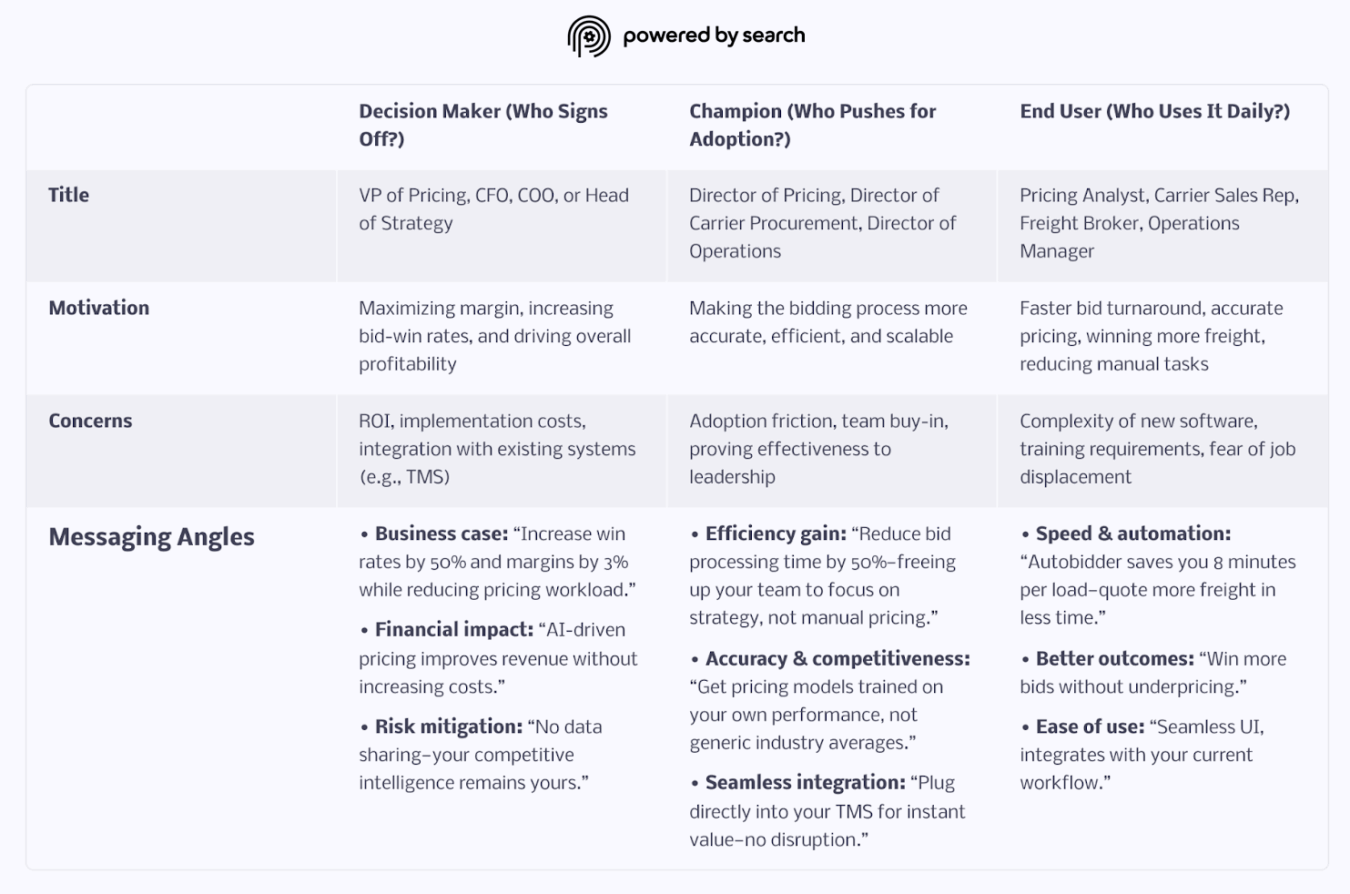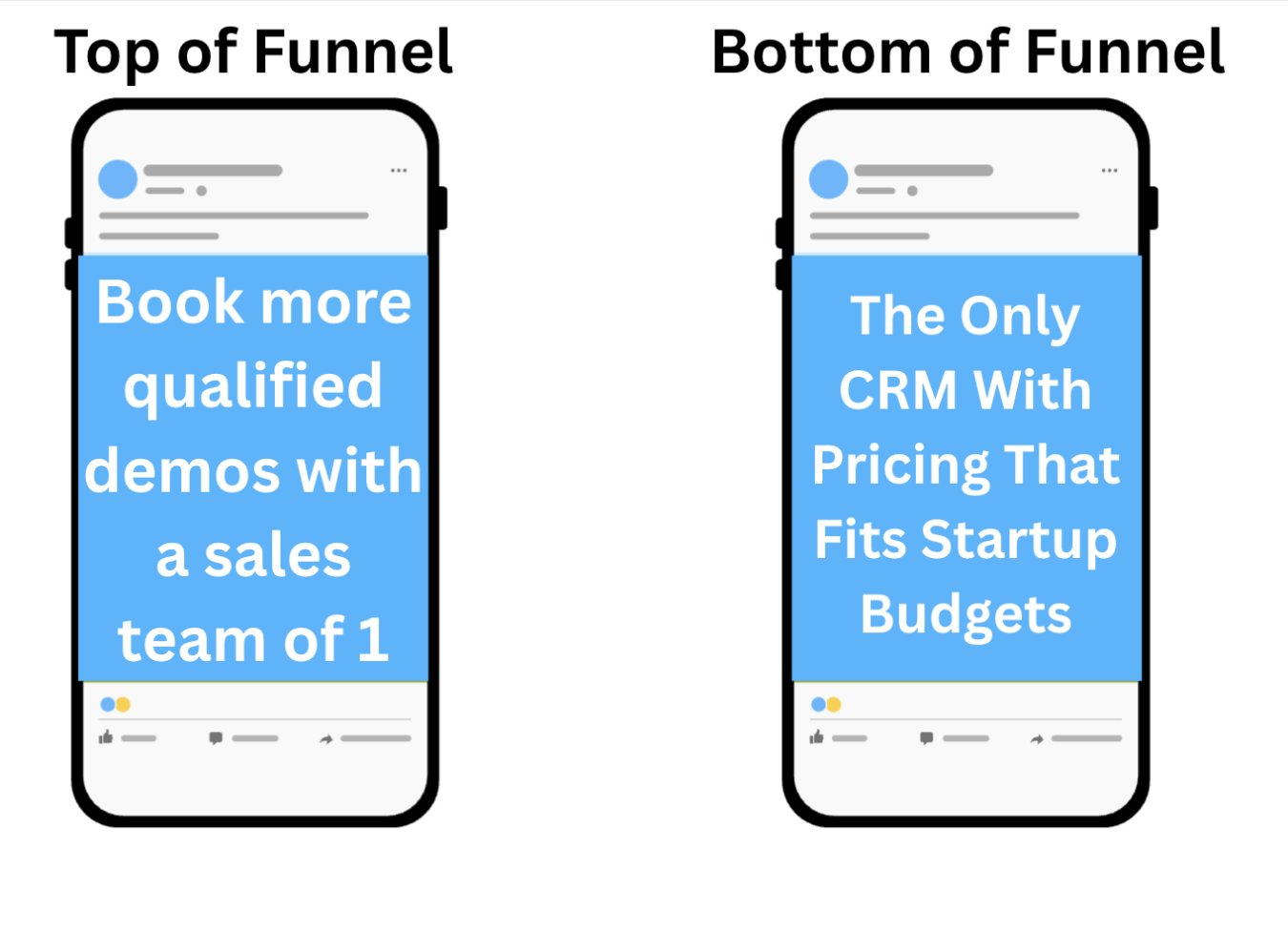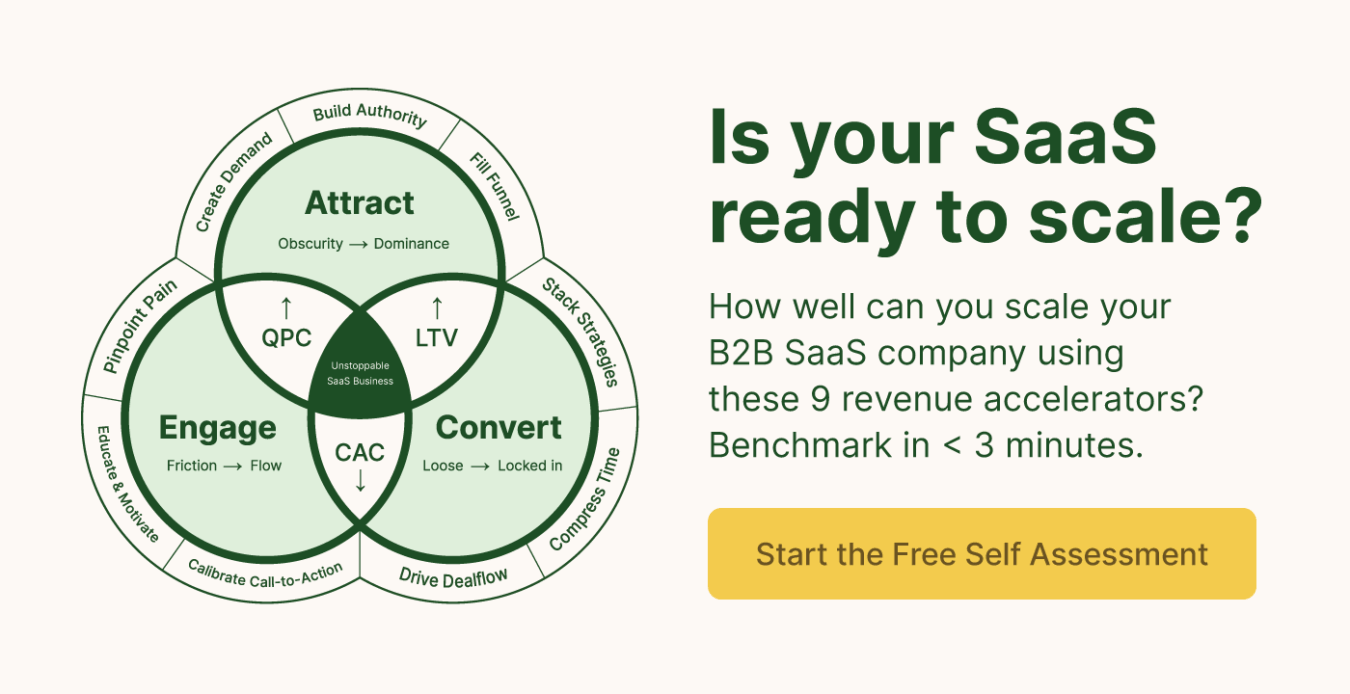How To Create a SaaS Buyer Persona That Improves Marketing ROI
Last updated: September 25th, 2025
Most marketers create a buyer persona that spells out who uses the product, those people’s pain points, and the benefits they’ll receive from using the product.
Yet after creating a SaaS buyer persona, one of two problems often occurs:
- Marketers don’t know how to use it to get better results.
- Marketers adjust some of the messaging across ads and landing pages, but conversions remain flat.
Either way, creating the SaaS buyer persona never actually improves performance.
In this post, we’ll explain the step-by-step process we use to create a SaaS buyer persona and how we use them to improve conversions.
What Is a SaaS Buyer Persona?
A SaaS buyer persona is a fictitious representation of your ideal customer, including demographics, firmographics, pain points, and desires.
The purpose of a SaaS buyer persona is to increase the ROI of your marketing campaigns in two ways:
- Improve targeting: The buyer persona tells you the exact demographics and firmographics, making it easy to pinpoint exactly who to target.
- Improve messaging: The buyer persona illustrates your ideal customer’s pain points, allowing you to create messaging that resonates.
The Anatomy of a SaaS Buyer Persona
The ideal SaaS buyer persona consists of these components:
- Demographics: Age, gender, location, education, income, job title
- Firmographics: Company size, industry, revenue, and number of employees.
- Pain points: Specific problems and challenges that your product solves.
- Desired outcomes: The main goal a prospect wants to achieve.
- Buying journey and objections: How a prospect becomes a customer from when they first become aware of your product to signing a deal and all of the objections along the way.
- Preferred channels and content: Which channels does the prospect use to learn about the product.
However, most B2B SaaS deals require buy-in from an entire buying committee – not just a single individual.
Therefore, we do this exercise for each member of the SaaS buyer persona, including:
- The Check Signer
- The Daily User
- The Manager
Why Your Buyer Persona Is Ineffective (Even if It Checks The Boxes Above)
Often, SaaS marketers have already built a SaaS buyer persona that checks all of the boxes above, but the persona still isn’t useful because they’re making one of these three mistakes.
Issue #1: Generic Messaging Targeting The General Buying Committee Rather Than Specific Individuals
Most B2B SaaS products are purchased by a buying committee (e.g., the check signer, manager, and end user) rather than a single person.
Yet, each person within the buying committee has very different pain points.
For example, messaging related to increasing ROI will likely resonate with the check signer, whereas improving efficiency will resonate with the end user.
Therefore, you can’t use the same ad and messaging for all individuals involved in the buying committee.
Yet often, we see SaaS companies make the mistake of diluting their messaging to accommodate all individuals involved in the buying committee.
For example, instead of focusing on the “higher ROI” benefit that resonates with the check signer, a SaaS company might also add in “faster and better user experience” to appease the end user.
Yet stringing multiple benefits together muddles the clarity of your value proposition and ultimately causes conversions to suffer.
Instead, we create a document ahead of time that clearly spells out the benefits of the product for different users.
In the example below, the Decision Maker’s primary motivation is maximizing margin, and increasing bid-win rates whereas the End User’s goal is faster bid turnaround.

Issue #2: The Right Messaging For The Right Person At The Wrong Time
Another nuance many SaaS marketers overlook is that each individual’s pain points and objections change as they move through the buyer journey.
The first objection you have to overcome is likely related to the higher level pain point (e.g., “how do I solve X problem?”).
As they move through the funnel, the objection will likely shift to competitive related questions (e.g., “how is this better, faster or cheaper than other products?”).
It’s your job to ensure the right people have the answers to those questions.
For example, let’s say you’re selling a Customer Data Platform to eCommerce organisations.
Early in the journey, you will need to convince the end user that they don’t need a developer to make use of it
As conversations being, the team’s developer needs to know that it fits within their existing tech stack and engineering capabilities. Then before sign-off happens, their CFO wants to know that there’s a strong business case for adopting a high-value piece of software.
If neither of these personas is able to find the information they need to absolve their objections, then the sale won’t go through.

So showing prospects at the top of the funnel a pricing related ad won’t resonate if they haven’t yet decided they want a CRM.
Issue #3: Creating a Buyer Persona Based on Assumptions Rather Than Data
We often see companies inaccurately assume the pain points of each buying committee member.
For example, you may think the CMO signing the check has a pain point related to improving lead volume. However, their real problem may be lead quality.
The difference between these two pain points is small, but an ad that mentions increasing lead volume won’t convert nearly as well as one mentioning the real problem of increasing lead quality.

The 4 Key Steps to Create and Implement Your SaaS Buyer Personas
Step 1: Select One Persona to Target First
An effective B2B SaaS buyer persona accounts for multiple individuals within the buying committee.
For context, here’s how we define each individual within the buyer persona:
- The Daily User generally wants a product that’s easy to use, saves them time, and helps them be more efficient.
- The Manager has standards he/she must maintain in their areas of responsibility. They typically want things like alerts, reports, and updates to measure progress.
- The Check Signer is mainly concerned with gaining insights that help with decision-making, and seeing that their ROI makes the cost of your product worth it.

In fact, one of our SaaS website design best practices is building out specific pages for each of these personas.

However, we start by targeting just one persona.
Why just one?
Ultimately, we will build out campaigns that target each individual member of the buying committee.
However, if you simultaneously launch several new campaigns, each targeting a different member of the buying committee, you won’t know which campaigns worked and which ones didn’t.
So which persona should we start with?
Ultimately, it’s whoever initiates the buyer journey.
Many marketers jump to target the Check Signer first, though this persona may only learn about the product after someone else in the organization (a daily user or manager) introduces it to them.
If you target the Check Signer first, your message likely won’t resonate because they may not even be aware that a problem exists.
For example, when we began working with TouchBistro, they’d been targeting restaurant owners (The Check Signer) and were seeing subpar results with their paid ads.
The problem is that the servers were usually the ones to initially discover TouchBistro, and then showed it to the owner, who ultimately got on the demo and purchased.
By switching to target servers instead (The Daily User), we saw a 200% increase in leads.
So to identify who initiates the conversation and advocates for your product, we do some customer research to learn:
- Who are their existing customers?
- Who was the first person sales spoke to?
- What was the engagement process like when they converted?
To gather data that answers this question (because guessing isn’t sufficient), we’ll talk to sales and cross check their qualitative insights with CRM data.
From there, we’ll identify which job titles are showing up the most which will help to inform which persona we should start with.
If you sell to larger companies, here are the three most common ways SaaS products are discovered:

If Scenario #1 or Scenario #3 is the most common case you see in your CRM, things are more straightforward about who to target.
But if Scenario #2 is the most common case leading to sales calls, from the surface it might look like you should target the person who called you (The Manager).
However, you’d actually want to start with The Daily User because they first discovered the product and advocate for your product internally.
This is why customer research is critical.
To discover the Scenario #2s, ask your sales team to learn how the manager discovered the product.
You’re more likely to encounter the multiple hats scenario if you’re selling to smaller businesses, where one person (often the business owner) will play the role of two or all three of the personas. In this situation, you want to try to figure out:
- What percentage of their day do they spend in each of the persona roles (Check Signer mode, Manager mode, and Daily User mode)?
- For the pain points your product solves, which persona are they most directly related to?
Which brings us to Step #2 in our process…
Step 2: How to Decide Which Problem to Target First (The Inverse of that Problem Will Be Your One Promise)
Once you have a persona, the next step is selecting the problem that our most valuable customers name as the chief pain point the product solves.
We usually look at the demo qualification process to identify this chief pain point.
If our client doesn’t have a well developed qualification process, we’ll use two other resources to help pinpoint the problem:
- Competitors: What are the feature and benefit pages of competitors saying?
- Reviews: What are the reviews (of the client and their competitors) on sites like G2 or Capterra saying?
After identifying what people say they like about you or your competitor’s product (i.e., the benefits), the problems you are solving for them are the inverse of those things.
For example, let’s say you sell reporting software, and the most common thing your customers say they like about your product is that it saves them time from manual reporting.
After doing customer research, you’ll probably have a long list of problems your product solves, so how do you choose one?
Additionally, many SaaS services solve multiple problems, so it’s challenging to choose just one.
However, stating multiple problems or value propositions will simply confuse your visitors.
Here’s our process to pick the most important problem:
- Lay the three problems out on the table.
- Ask yourself, if you absolutely had to get rid of one and narrow it down to two problems, which would you get rid of?
- Then, with the two remaining problems, do this again. If you absolutely had to get rid of one of these problems, what would be left?
Once you’ve narrowed your focus down to one problem, the inverse of this problem is the promise you’ll make. To continue with our reporting software example from above, if the problem is “hours spent manually compiling client reports each week,” your promise might be “Save 3+ hours per week with our automated reporting software.”

With your one persona, one problem, and one promise in hand, it’s very easy to craft content and messaging for landing pages and ads that resonate with your persona.
Step 3: Set Up and Launch Your Campaign to Target Your First Persona
There is a lot that goes into setting up and launching your campaigns successfully once you reach this point, and we’ve already explained our process for testing paid media channels in detail so that you can get this step right.
One of the most important things to consider at this stage is:
Are we serving them this message at the most opportune time?
As mentioned earlier, a common mistake SaaS companies make is serving the right ad to the right audience at the wrong time.
So if you’re launching a top of funnel campaign, don’t immediately ask them to sign up for a demo.
Instead, offer a lead magnet like a guide or free calculator, depending on their level of awareness.
Our SaaS buyer awareness matrix explains this in more detail, but here’s a brief overview of what we might offer at the different stages of awareness:
- TOFU: Awareness content like ultimate guides or checklists.
- MOFU: Use cases, social proof
- BOFU: ROI calculators, demos
Only when we’ve gained traction with this first persona will we launch campaigns targeted at the second persona.
Step 4: Scale to the Next Persona (Usually After About One Quarter)
Lead velocity is the key metric we use to decide when it’s time to add in campaigns that target the second most important persona.
Once we see our client’s pipeline filling up with qualified prospects and we see trial downloads or demos have increased, it’s usually a good indicator that targeting a second persona can now add value to our marketing efforts.
Another indicator that it’s time to add in a second persona is if multiple personas are beginning to show up more in sales conversations. For example, if you start with targeting The Manager and you find The Check Signers are consistently coming along too, it’s probably time to begin creating ads and content that help them understand what you offer.
This way when they’re involved in sales conversations they’re more likely to be familiar with your service.
And you can avoid the problem that comes up when managers are the ones telling the story of your product instead of you (often not describing it how you’d want them to).
Note: When we begin targeting multiple personas, each has their own ad copy, content, and landing page that is specific to that persona and their pain points. The point is NOT to begin targeting them together (making the mistake this entire process is meant to avoid in the first place).
How To Further Improve The Efficacy of Your Buyer Persona
Simply creating a buyer persona won’t make your marketing more effective. The real ROI is in the nuances of each campaign, like crafting the copy and creative.
This is where it can be useful to work with a team of SaaS experts that have years of experience working with other similar SaaS companies.
Instead of wasting money on endless A/B tests as you work to dial in the perfect positioning for your campaigns based on your new buyer persona, consider working with a team that’s done this for dozens of other SaaS companies.
Here at Powered By Search, leveraging buyer persona data to implement campaigns is one of our core principles. Reach out to our team of experts today to learn how we can help you take your campaigns to the next level.
What you should do now
Whenever you’re ready…here are 4 ways we can help you grow your B2B software or technology business:
- Claim your Free Marketing Plan. If you’d like to work with us to turn your website into your best demo and trial acquisition platform, claim your FREE Marketing Plan. One of our growth experts will understand your current demand generation situation, and then suggest practical digital marketing strategies to hit your pipeline targets with certainty and predictability.
- If you’d like to learn the exact demand strategies we use for free, go to our blog or visit our resources section, where you can download guides, calculators, and templates we use for our most successful clients.
- If you’d like to work with other experts on our team or learn why we have off the charts team member satisfaction score, then see our Careers page.
- If you know another marketer who’d enjoy reading this page, share it with them via email, Linkedin, Twitter, or Facebook.
